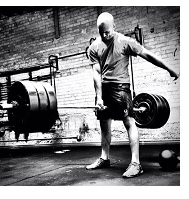WEIGHT
TRAINING
Weight Lifting
Increase Muscle Size
Equipment
Weight Loss
Squats
Fitness
Body Mass Index
Strength Training
Health
Heart Health
Joint Health
Back Injury
Kids
Woman
Fitness After 40
|
Weightlifting Techniques - The Deadlift
In weightlifting it is very important to know, and follow, the proper techniques to achieve the desired benefit of a given weight lifting exercise. Lifting incorrectly not only can work the wrong muscles but also may cause severe muscle strain or other, more dangerous, injuries. Despite the popular motivational expression "no pain - no gain". Weight lifting when done correctly should not hurt, if you are experiencing physical pain during or after a weight lifting workout, chances are you are using the wrong amount of weight or incorrect technique.
 The Deadlift is a popular weight lifting exercise in competition and for professional and personal training. It is the classic weightlifting technique where one grasps a barbell that is on the floor from a squatting position and stands up bringing the barbell to just past the knees. It is the ultimate "test of strength" and is the key movement in competitive powerlifting. While you start from a "squatted" position A Deadlift is unlike a Squat or most other weight lift techniques for that matter, because as its name implies you are lifting a "dead weight". In other words a weight that is not already in motion or other wise already off the ground. It is for this reason that it really puts the muscles to the test, and can also be quite risky if done wrong. The Deadlift works just about every muscle group of the lower body including the abs, the lower back and the back. Other muscle groups involved include the hips, thighs, hamstrings, calves and glutes. To some degree the Deadlift also works the trapeziums (upper back and holders) and the forearms. The Deadlift is a popular weight lifting exercise in competition and for professional and personal training. It is the classic weightlifting technique where one grasps a barbell that is on the floor from a squatting position and stands up bringing the barbell to just past the knees. It is the ultimate "test of strength" and is the key movement in competitive powerlifting. While you start from a "squatted" position A Deadlift is unlike a Squat or most other weight lift techniques for that matter, because as its name implies you are lifting a "dead weight". In other words a weight that is not already in motion or other wise already off the ground. It is for this reason that it really puts the muscles to the test, and can also be quite risky if done wrong. The Deadlift works just about every muscle group of the lower body including the abs, the lower back and the back. Other muscle groups involved include the hips, thighs, hamstrings, calves and glutes. To some degree the Deadlift also works the trapeziums (upper back and holders) and the forearms.
Proper Lift
To Deadlift, grab the bar with a comfortable grip; legs should be shoulder length apart. Lower body into a squatting position with hips parallel to the floor, back straight, eyes looking forward. Tighten your stomach muscles, and raise yourself and the bar "pushing" with your leg muscles and extending your hips, you are not lifting the weight with your arms or your back. The bar should come to a position above your knees and in front of the hips. Do not round you shoulders. Return the bar slowly to the ground and repeat. The biggest mistake people make in a Deadlift that can cause serious injury is trying to lift with the arms, back, or other muscles of the upper body. While some of these groups will be worked in a Deadlift, the Deadlift is not an upper body weightlifting exercise. To avoid this it is helpful for the lifter to envision trying to push the legs and hips through the floor rather then pulling up on the bar with your arms and back.
Risk
The serious risk to improper lifting in a "dead" lift is back injury. It is imperative to keep the back straight during a dead lift. If you do not this can put stress on the disks and lead to all manner of back problems. A lifting belt could stabilize the lower back and is a good idea if you already have a back condition, however some pros say that lifting belts prevent you from strengthening the very areas that are in need of help in people with back pain.
Variations
In the weight lifting community, you will find a few variations of the Deadlift, such as the Romanian Deadlift, which is not really a Deadlift at all since in this variation after initial lift, you do not return the bar to the floor. It is designed to work more of the thighs and hamstrings.
Record
As this is being written, the world record for the Deadlift is held by weight lifter Andy Bolton, an English powerlifter from Leeds, who pulled 1003 pounds (455 kg), the first ever Deadlift over 1000 pounds, but this may have been broken by the time you read this.
|


|


